The Role of Evidence-Based Practice in Nursing and Patient Care
VerifiedAdded on 2020/05/04
|10
|2193
|48
Essay
AI Summary
This essay explores the application of evidence-based practice (EBP) in nursing, emphasizing its role in improving patient outcomes and enhancing the quality of care. The author defines EBP as the use of current research and studies in nursing practice, highlighting its integration with standards of practice to optimize patient care. The essay details how EBP, supported by continuous professional learning and research findings, equips nurses with the knowledge to improve patient outcomes. It also examines the theoretical and clinical applications of EBP, including the ACE Star model for knowledge translation. Furthermore, the essay argues that training and support are essential for nurses to effectively implement EBP in clinical settings, and it discusses the challenges nurses face, such as the need for continuous learning and support from healthcare departments. The conclusion reinforces the importance of EBP in nursing and the necessity of training and support for successful implementation.

Running head: NURSING 1
Nursing
Student Name
Institution
Nursing
Student Name
Institution
Paraphrase This Document
Need a fresh take? Get an instant paraphrase of this document with our AI Paraphraser
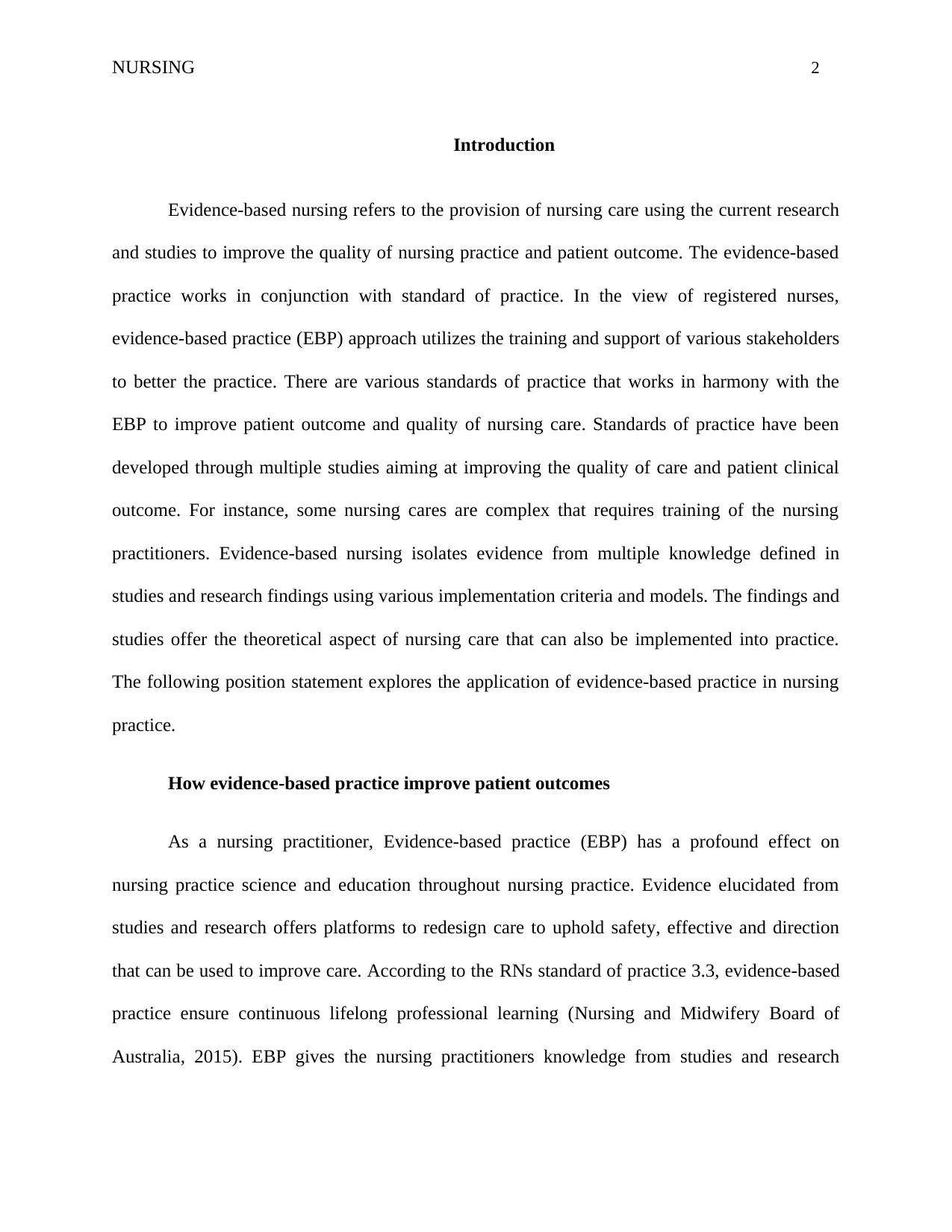
NURSING 2
Introduction
Evidence-based nursing refers to the provision of nursing care using the current research
and studies to improve the quality of nursing practice and patient outcome. The evidence-based
practice works in conjunction with standard of practice. In the view of registered nurses,
evidence-based practice (EBP) approach utilizes the training and support of various stakeholders
to better the practice. There are various standards of practice that works in harmony with the
EBP to improve patient outcome and quality of nursing care. Standards of practice have been
developed through multiple studies aiming at improving the quality of care and patient clinical
outcome. For instance, some nursing cares are complex that requires training of the nursing
practitioners. Evidence-based nursing isolates evidence from multiple knowledge defined in
studies and research findings using various implementation criteria and models. The findings and
studies offer the theoretical aspect of nursing care that can also be implemented into practice.
The following position statement explores the application of evidence-based practice in nursing
practice.
How evidence-based practice improve patient outcomes
As a nursing practitioner, Evidence-based practice (EBP) has a profound effect on
nursing practice science and education throughout nursing practice. Evidence elucidated from
studies and research offers platforms to redesign care to uphold safety, effective and direction
that can be used to improve care. According to the RNs standard of practice 3.3, evidence-based
practice ensure continuous lifelong professional learning (Nursing and Midwifery Board of
Australia, 2015). EBP gives the nursing practitioners knowledge from studies and research
Introduction
Evidence-based nursing refers to the provision of nursing care using the current research
and studies to improve the quality of nursing practice and patient outcome. The evidence-based
practice works in conjunction with standard of practice. In the view of registered nurses,
evidence-based practice (EBP) approach utilizes the training and support of various stakeholders
to better the practice. There are various standards of practice that works in harmony with the
EBP to improve patient outcome and quality of nursing care. Standards of practice have been
developed through multiple studies aiming at improving the quality of care and patient clinical
outcome. For instance, some nursing cares are complex that requires training of the nursing
practitioners. Evidence-based nursing isolates evidence from multiple knowledge defined in
studies and research findings using various implementation criteria and models. The findings and
studies offer the theoretical aspect of nursing care that can also be implemented into practice.
The following position statement explores the application of evidence-based practice in nursing
practice.
How evidence-based practice improve patient outcomes
As a nursing practitioner, Evidence-based practice (EBP) has a profound effect on
nursing practice science and education throughout nursing practice. Evidence elucidated from
studies and research offers platforms to redesign care to uphold safety, effective and direction
that can be used to improve care. According to the RNs standard of practice 3.3, evidence-based
practice ensure continuous lifelong professional learning (Nursing and Midwifery Board of
Australia, 2015). EBP gives the nursing practitioners knowledge from studies and research
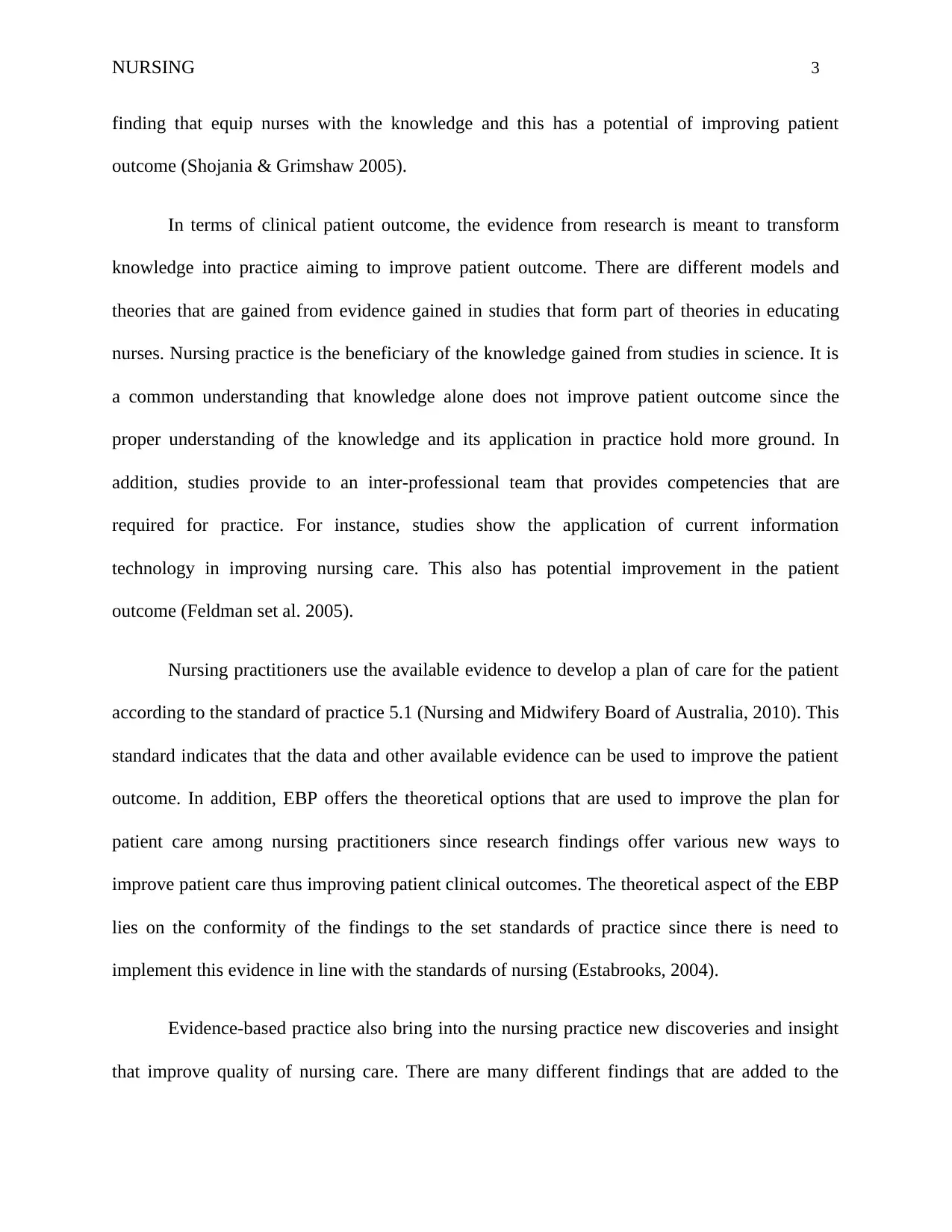
NURSING 3
finding that equip nurses with the knowledge and this has a potential of improving patient
outcome (Shojania & Grimshaw 2005).
In terms of clinical patient outcome, the evidence from research is meant to transform
knowledge into practice aiming to improve patient outcome. There are different models and
theories that are gained from evidence gained in studies that form part of theories in educating
nurses. Nursing practice is the beneficiary of the knowledge gained from studies in science. It is
a common understanding that knowledge alone does not improve patient outcome since the
proper understanding of the knowledge and its application in practice hold more ground. In
addition, studies provide to an inter-professional team that provides competencies that are
required for practice. For instance, studies show the application of current information
technology in improving nursing care. This also has potential improvement in the patient
outcome (Feldman set al. 2005).
Nursing practitioners use the available evidence to develop a plan of care for the patient
according to the standard of practice 5.1 (Nursing and Midwifery Board of Australia, 2010). This
standard indicates that the data and other available evidence can be used to improve the patient
outcome. In addition, EBP offers the theoretical options that are used to improve the plan for
patient care among nursing practitioners since research findings offer various new ways to
improve patient care thus improving patient clinical outcomes. The theoretical aspect of the EBP
lies on the conformity of the findings to the set standards of practice since there is need to
implement this evidence in line with the standards of nursing (Estabrooks, 2004).
Evidence-based practice also bring into the nursing practice new discoveries and insight
that improve quality of nursing care. There are many different findings that are added to the
finding that equip nurses with the knowledge and this has a potential of improving patient
outcome (Shojania & Grimshaw 2005).
In terms of clinical patient outcome, the evidence from research is meant to transform
knowledge into practice aiming to improve patient outcome. There are different models and
theories that are gained from evidence gained in studies that form part of theories in educating
nurses. Nursing practice is the beneficiary of the knowledge gained from studies in science. It is
a common understanding that knowledge alone does not improve patient outcome since the
proper understanding of the knowledge and its application in practice hold more ground. In
addition, studies provide to an inter-professional team that provides competencies that are
required for practice. For instance, studies show the application of current information
technology in improving nursing care. This also has potential improvement in the patient
outcome (Feldman set al. 2005).
Nursing practitioners use the available evidence to develop a plan of care for the patient
according to the standard of practice 5.1 (Nursing and Midwifery Board of Australia, 2010). This
standard indicates that the data and other available evidence can be used to improve the patient
outcome. In addition, EBP offers the theoretical options that are used to improve the plan for
patient care among nursing practitioners since research findings offer various new ways to
improve patient care thus improving patient clinical outcomes. The theoretical aspect of the EBP
lies on the conformity of the findings to the set standards of practice since there is need to
implement this evidence in line with the standards of nursing (Estabrooks, 2004).
Evidence-based practice also bring into the nursing practice new discoveries and insight
that improve quality of nursing care. There are many different findings that are added to the
⊘ This is a preview!⊘
Do you want full access?
Subscribe today to unlock all pages.

Trusted by 1+ million students worldwide
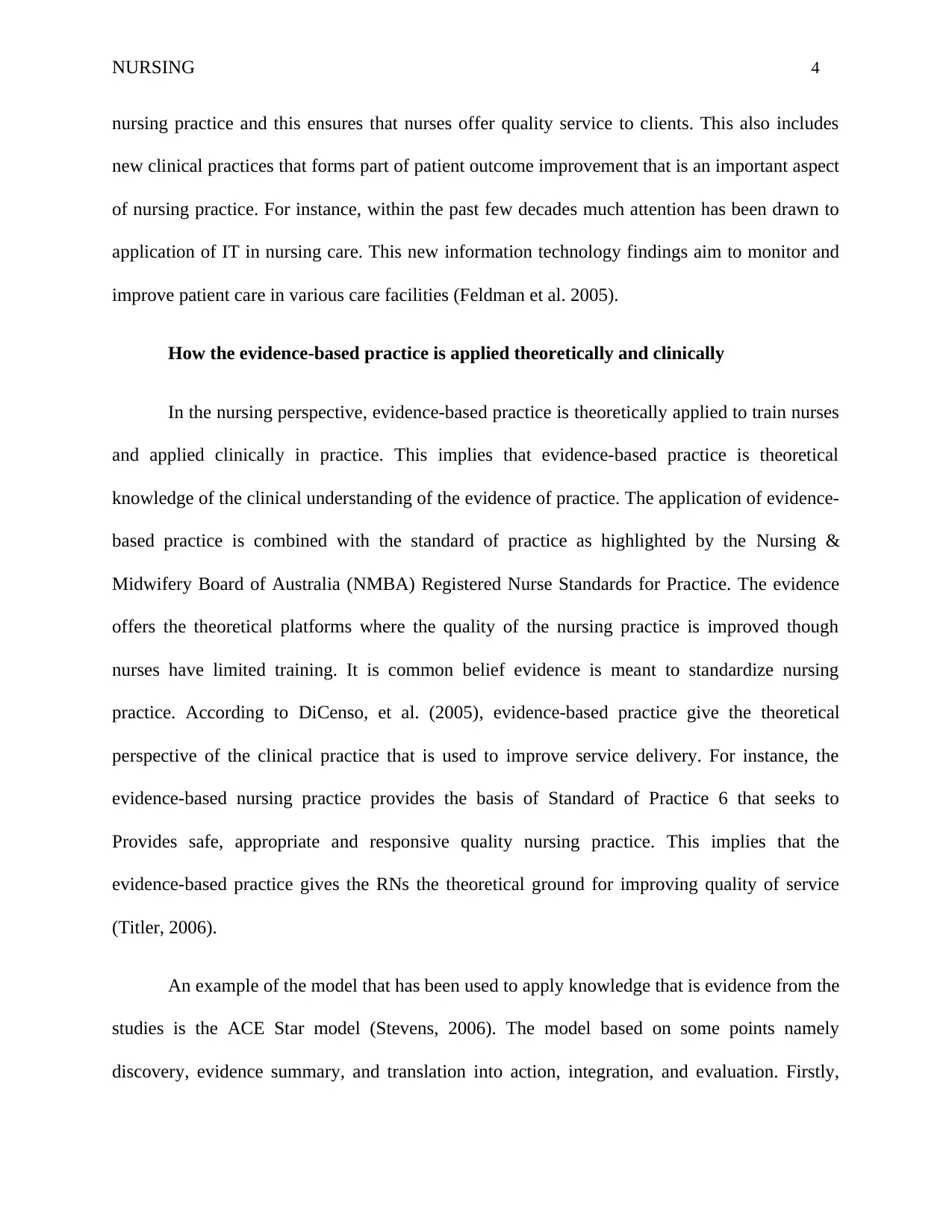
NURSING 4
nursing practice and this ensures that nurses offer quality service to clients. This also includes
new clinical practices that forms part of patient outcome improvement that is an important aspect
of nursing practice. For instance, within the past few decades much attention has been drawn to
application of IT in nursing care. This new information technology findings aim to monitor and
improve patient care in various care facilities (Feldman et al. 2005).
How the evidence-based practice is applied theoretically and clinically
In the nursing perspective, evidence-based practice is theoretically applied to train nurses
and applied clinically in practice. This implies that evidence-based practice is theoretical
knowledge of the clinical understanding of the evidence of practice. The application of evidence-
based practice is combined with the standard of practice as highlighted by the Nursing &
Midwifery Board of Australia (NMBA) Registered Nurse Standards for Practice. The evidence
offers the theoretical platforms where the quality of the nursing practice is improved though
nurses have limited training. It is common belief evidence is meant to standardize nursing
practice. According to DiCenso, et al. (2005), evidence-based practice give the theoretical
perspective of the clinical practice that is used to improve service delivery. For instance, the
evidence-based nursing practice provides the basis of Standard of Practice 6 that seeks to
Provides safe, appropriate and responsive quality nursing practice. This implies that the
evidence-based practice gives the RNs the theoretical ground for improving quality of service
(Titler, 2006).
An example of the model that has been used to apply knowledge that is evidence from the
studies is the ACE Star model (Stevens, 2006). The model based on some points namely
discovery, evidence summary, and translation into action, integration, and evaluation. Firstly,
nursing practice and this ensures that nurses offer quality service to clients. This also includes
new clinical practices that forms part of patient outcome improvement that is an important aspect
of nursing practice. For instance, within the past few decades much attention has been drawn to
application of IT in nursing care. This new information technology findings aim to monitor and
improve patient care in various care facilities (Feldman et al. 2005).
How the evidence-based practice is applied theoretically and clinically
In the nursing perspective, evidence-based practice is theoretically applied to train nurses
and applied clinically in practice. This implies that evidence-based practice is theoretical
knowledge of the clinical understanding of the evidence of practice. The application of evidence-
based practice is combined with the standard of practice as highlighted by the Nursing &
Midwifery Board of Australia (NMBA) Registered Nurse Standards for Practice. The evidence
offers the theoretical platforms where the quality of the nursing practice is improved though
nurses have limited training. It is common belief evidence is meant to standardize nursing
practice. According to DiCenso, et al. (2005), evidence-based practice give the theoretical
perspective of the clinical practice that is used to improve service delivery. For instance, the
evidence-based nursing practice provides the basis of Standard of Practice 6 that seeks to
Provides safe, appropriate and responsive quality nursing practice. This implies that the
evidence-based practice gives the RNs the theoretical ground for improving quality of service
(Titler, 2006).
An example of the model that has been used to apply knowledge that is evidence from the
studies is the ACE Star model (Stevens, 2006). The model based on some points namely
discovery, evidence summary, and translation into action, integration, and evaluation. Firstly,
Paraphrase This Document
Need a fresh take? Get an instant paraphrase of this document with our AI Paraphraser
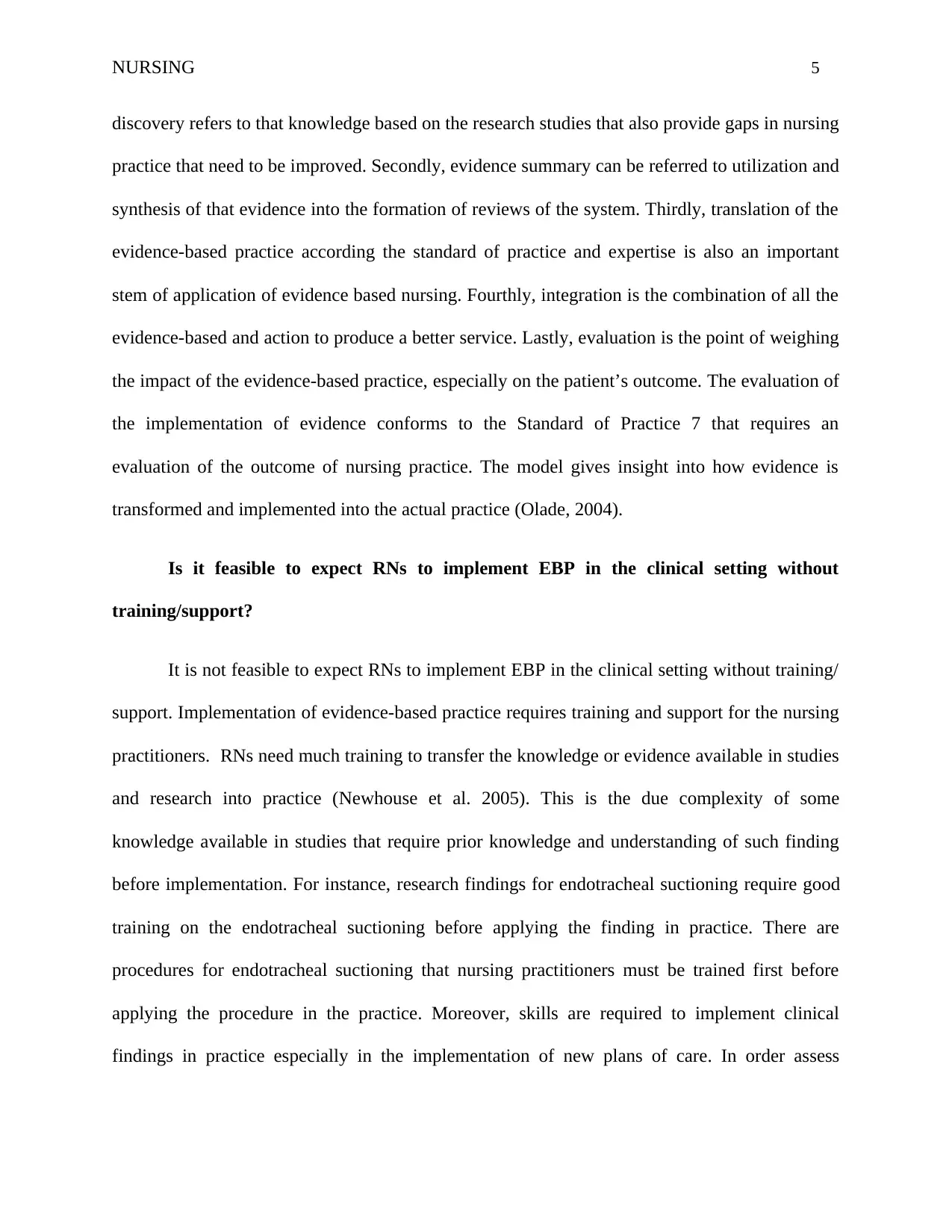
NURSING 5
discovery refers to that knowledge based on the research studies that also provide gaps in nursing
practice that need to be improved. Secondly, evidence summary can be referred to utilization and
synthesis of that evidence into the formation of reviews of the system. Thirdly, translation of the
evidence-based practice according the standard of practice and expertise is also an important
stem of application of evidence based nursing. Fourthly, integration is the combination of all the
evidence-based and action to produce a better service. Lastly, evaluation is the point of weighing
the impact of the evidence-based practice, especially on the patient’s outcome. The evaluation of
the implementation of evidence conforms to the Standard of Practice 7 that requires an
evaluation of the outcome of nursing practice. The model gives insight into how evidence is
transformed and implemented into the actual practice (Olade, 2004).
Is it feasible to expect RNs to implement EBP in the clinical setting without
training/support?
It is not feasible to expect RNs to implement EBP in the clinical setting without training/
support. Implementation of evidence-based practice requires training and support for the nursing
practitioners. RNs need much training to transfer the knowledge or evidence available in studies
and research into practice (Newhouse et al. 2005). This is the due complexity of some
knowledge available in studies that require prior knowledge and understanding of such finding
before implementation. For instance, research findings for endotracheal suctioning require good
training on the endotracheal suctioning before applying the finding in practice. There are
procedures for endotracheal suctioning that nursing practitioners must be trained first before
applying the procedure in the practice. Moreover, skills are required to implement clinical
findings in practice especially in the implementation of new plans of care. In order assess
discovery refers to that knowledge based on the research studies that also provide gaps in nursing
practice that need to be improved. Secondly, evidence summary can be referred to utilization and
synthesis of that evidence into the formation of reviews of the system. Thirdly, translation of the
evidence-based practice according the standard of practice and expertise is also an important
stem of application of evidence based nursing. Fourthly, integration is the combination of all the
evidence-based and action to produce a better service. Lastly, evaluation is the point of weighing
the impact of the evidence-based practice, especially on the patient’s outcome. The evaluation of
the implementation of evidence conforms to the Standard of Practice 7 that requires an
evaluation of the outcome of nursing practice. The model gives insight into how evidence is
transformed and implemented into the actual practice (Olade, 2004).
Is it feasible to expect RNs to implement EBP in the clinical setting without
training/support?
It is not feasible to expect RNs to implement EBP in the clinical setting without training/
support. Implementation of evidence-based practice requires training and support for the nursing
practitioners. RNs need much training to transfer the knowledge or evidence available in studies
and research into practice (Newhouse et al. 2005). This is the due complexity of some
knowledge available in studies that require prior knowledge and understanding of such finding
before implementation. For instance, research findings for endotracheal suctioning require good
training on the endotracheal suctioning before applying the finding in practice. There are
procedures for endotracheal suctioning that nursing practitioners must be trained first before
applying the procedure in the practice. Moreover, skills are required to implement clinical
findings in practice especially in the implementation of new plans of care. In order assess
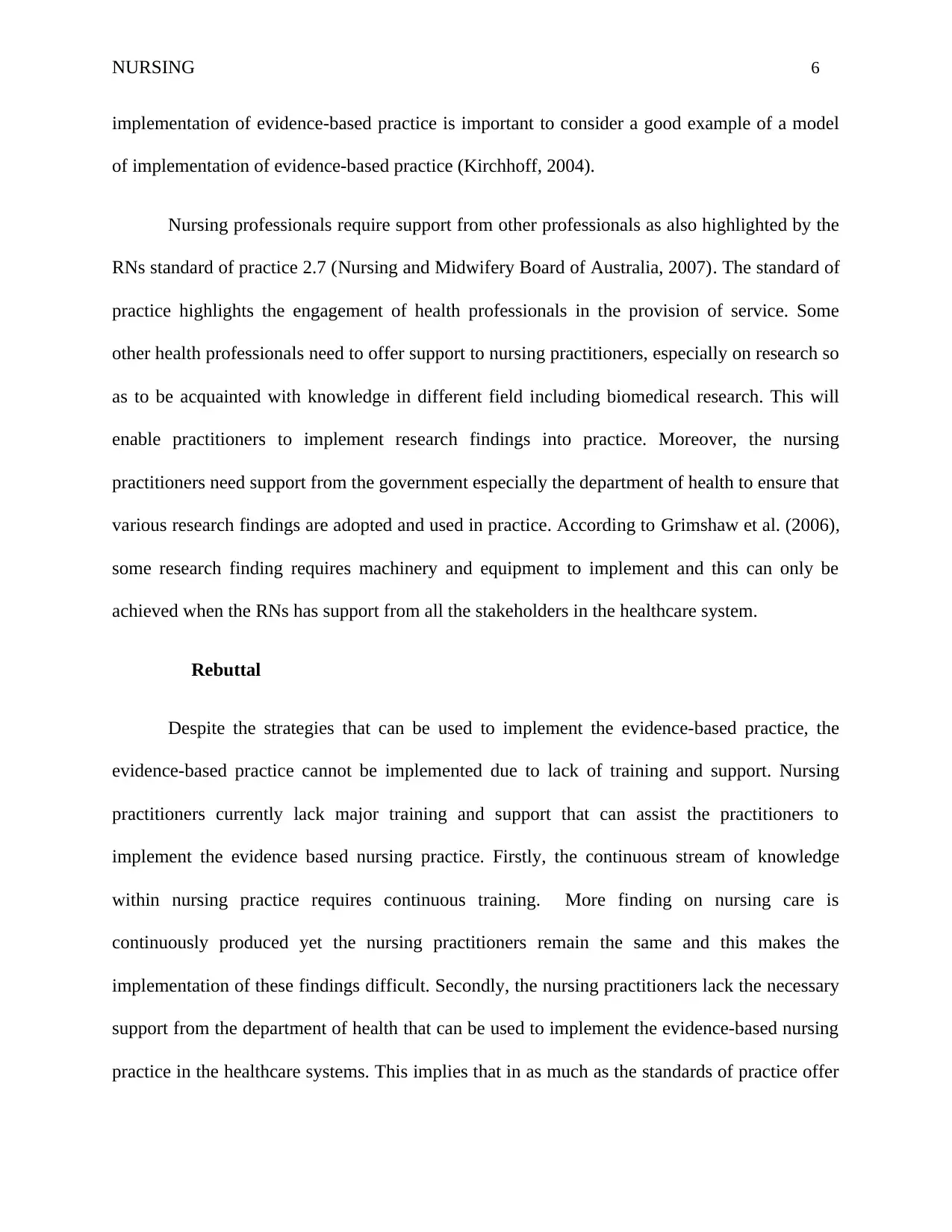
NURSING 6
implementation of evidence-based practice is important to consider a good example of a model
of implementation of evidence-based practice (Kirchhoff, 2004).
Nursing professionals require support from other professionals as also highlighted by the
RNs standard of practice 2.7 (Nursing and Midwifery Board of Australia, 2007). The standard of
practice highlights the engagement of health professionals in the provision of service. Some
other health professionals need to offer support to nursing practitioners, especially on research so
as to be acquainted with knowledge in different field including biomedical research. This will
enable practitioners to implement research findings into practice. Moreover, the nursing
practitioners need support from the government especially the department of health to ensure that
various research findings are adopted and used in practice. According to Grimshaw et al. (2006),
some research finding requires machinery and equipment to implement and this can only be
achieved when the RNs has support from all the stakeholders in the healthcare system.
Rebuttal
Despite the strategies that can be used to implement the evidence-based practice, the
evidence-based practice cannot be implemented due to lack of training and support. Nursing
practitioners currently lack major training and support that can assist the practitioners to
implement the evidence based nursing practice. Firstly, the continuous stream of knowledge
within nursing practice requires continuous training. More finding on nursing care is
continuously produced yet the nursing practitioners remain the same and this makes the
implementation of these findings difficult. Secondly, the nursing practitioners lack the necessary
support from the department of health that can be used to implement the evidence-based nursing
practice in the healthcare systems. This implies that in as much as the standards of practice offer
implementation of evidence-based practice is important to consider a good example of a model
of implementation of evidence-based practice (Kirchhoff, 2004).
Nursing professionals require support from other professionals as also highlighted by the
RNs standard of practice 2.7 (Nursing and Midwifery Board of Australia, 2007). The standard of
practice highlights the engagement of health professionals in the provision of service. Some
other health professionals need to offer support to nursing practitioners, especially on research so
as to be acquainted with knowledge in different field including biomedical research. This will
enable practitioners to implement research findings into practice. Moreover, the nursing
practitioners need support from the government especially the department of health to ensure that
various research findings are adopted and used in practice. According to Grimshaw et al. (2006),
some research finding requires machinery and equipment to implement and this can only be
achieved when the RNs has support from all the stakeholders in the healthcare system.
Rebuttal
Despite the strategies that can be used to implement the evidence-based practice, the
evidence-based practice cannot be implemented due to lack of training and support. Nursing
practitioners currently lack major training and support that can assist the practitioners to
implement the evidence based nursing practice. Firstly, the continuous stream of knowledge
within nursing practice requires continuous training. More finding on nursing care is
continuously produced yet the nursing practitioners remain the same and this makes the
implementation of these findings difficult. Secondly, the nursing practitioners lack the necessary
support from the department of health that can be used to implement the evidence-based nursing
practice in the healthcare systems. This implies that in as much as the standards of practice offer
⊘ This is a preview!⊘
Do you want full access?
Subscribe today to unlock all pages.

Trusted by 1+ million students worldwide
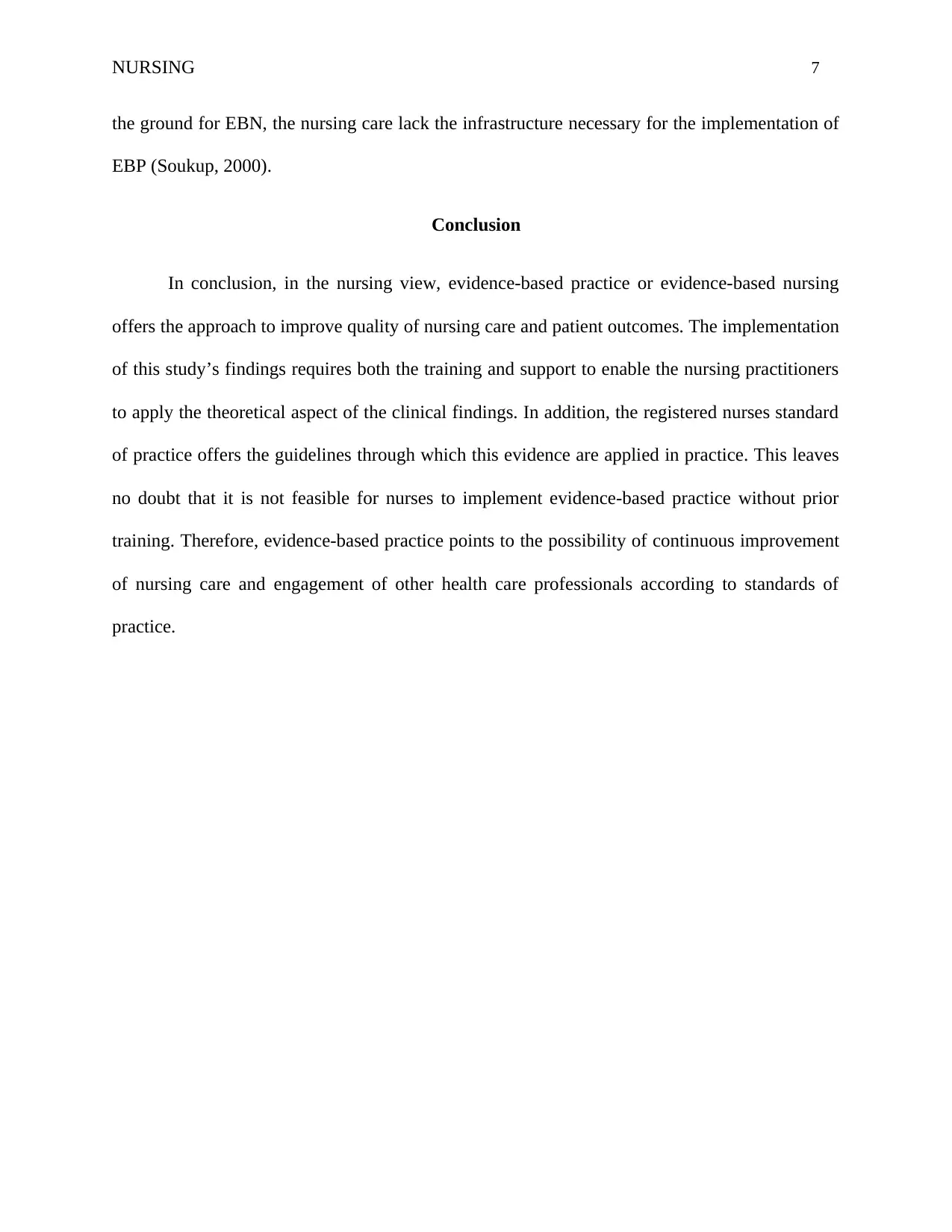
NURSING 7
the ground for EBN, the nursing care lack the infrastructure necessary for the implementation of
EBP (Soukup, 2000).
Conclusion
In conclusion, in the nursing view, evidence-based practice or evidence-based nursing
offers the approach to improve quality of nursing care and patient outcomes. The implementation
of this study’s findings requires both the training and support to enable the nursing practitioners
to apply the theoretical aspect of the clinical findings. In addition, the registered nurses standard
of practice offers the guidelines through which this evidence are applied in practice. This leaves
no doubt that it is not feasible for nurses to implement evidence-based practice without prior
training. Therefore, evidence-based practice points to the possibility of continuous improvement
of nursing care and engagement of other health care professionals according to standards of
practice.
the ground for EBN, the nursing care lack the infrastructure necessary for the implementation of
EBP (Soukup, 2000).
Conclusion
In conclusion, in the nursing view, evidence-based practice or evidence-based nursing
offers the approach to improve quality of nursing care and patient outcomes. The implementation
of this study’s findings requires both the training and support to enable the nursing practitioners
to apply the theoretical aspect of the clinical findings. In addition, the registered nurses standard
of practice offers the guidelines through which this evidence are applied in practice. This leaves
no doubt that it is not feasible for nurses to implement evidence-based practice without prior
training. Therefore, evidence-based practice points to the possibility of continuous improvement
of nursing care and engagement of other health care professionals according to standards of
practice.
Paraphrase This Document
Need a fresh take? Get an instant paraphrase of this document with our AI Paraphraser
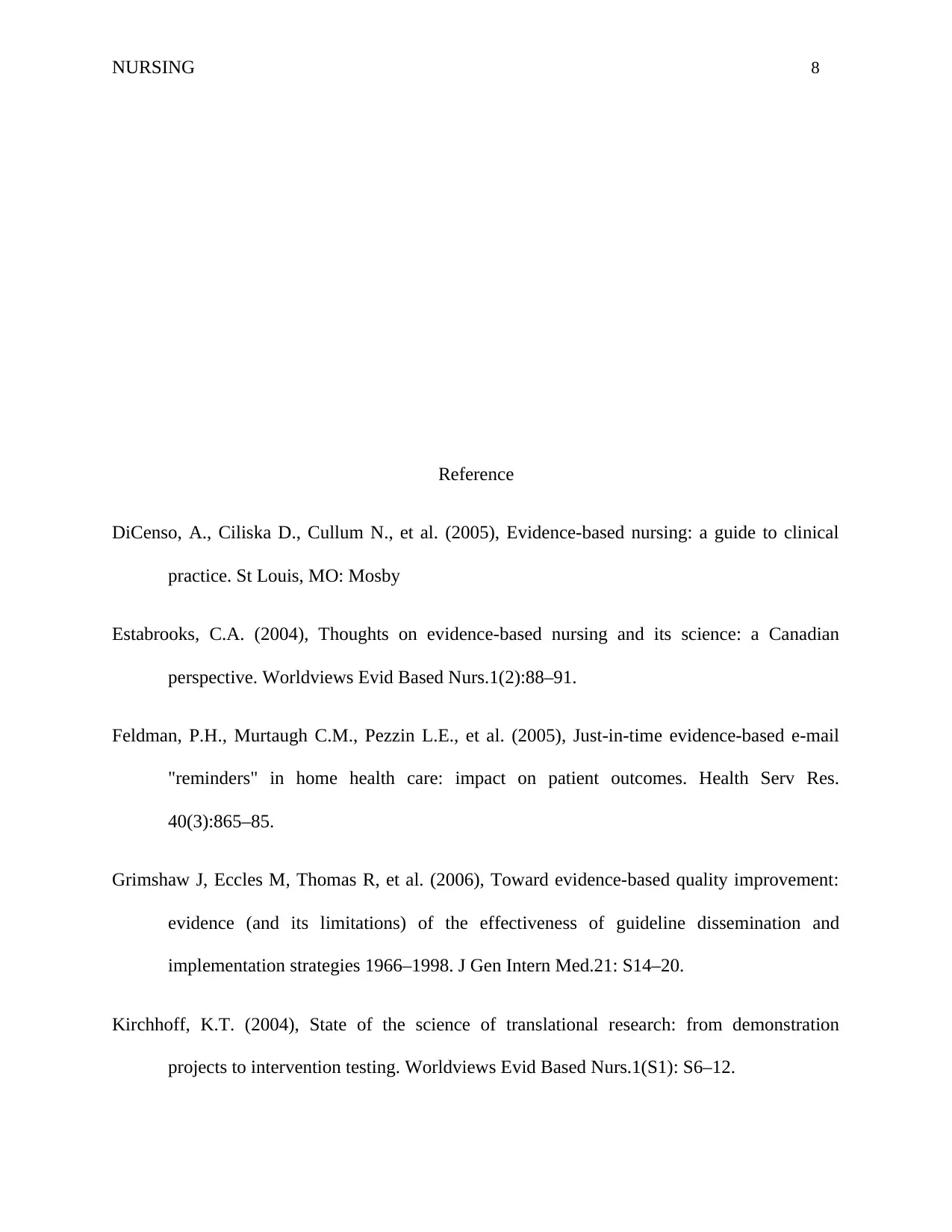
NURSING 8
Reference
DiCenso, A., Ciliska D., Cullum N., et al. (2005), Evidence-based nursing: a guide to clinical
practice. St Louis, MO: Mosby
Estabrooks, C.A. (2004), Thoughts on evidence-based nursing and its science: a Canadian
perspective. Worldviews Evid Based Nurs.1(2):88–91.
Feldman, P.H., Murtaugh C.M., Pezzin L.E., et al. (2005), Just-in-time evidence-based e-mail
"reminders" in home health care: impact on patient outcomes. Health Serv Res.
40(3):865–85.
Grimshaw J, Eccles M, Thomas R, et al. (2006), Toward evidence-based quality improvement:
evidence (and its limitations) of the effectiveness of guideline dissemination and
implementation strategies 1966–1998. J Gen Intern Med.21: S14–20.
Kirchhoff, K.T. (2004), State of the science of translational research: from demonstration
projects to intervention testing. Worldviews Evid Based Nurs.1(S1): S6–12.
Reference
DiCenso, A., Ciliska D., Cullum N., et al. (2005), Evidence-based nursing: a guide to clinical
practice. St Louis, MO: Mosby
Estabrooks, C.A. (2004), Thoughts on evidence-based nursing and its science: a Canadian
perspective. Worldviews Evid Based Nurs.1(2):88–91.
Feldman, P.H., Murtaugh C.M., Pezzin L.E., et al. (2005), Just-in-time evidence-based e-mail
"reminders" in home health care: impact on patient outcomes. Health Serv Res.
40(3):865–85.
Grimshaw J, Eccles M, Thomas R, et al. (2006), Toward evidence-based quality improvement:
evidence (and its limitations) of the effectiveness of guideline dissemination and
implementation strategies 1966–1998. J Gen Intern Med.21: S14–20.
Kirchhoff, K.T. (2004), State of the science of translational research: from demonstration
projects to intervention testing. Worldviews Evid Based Nurs.1(S1): S6–12.
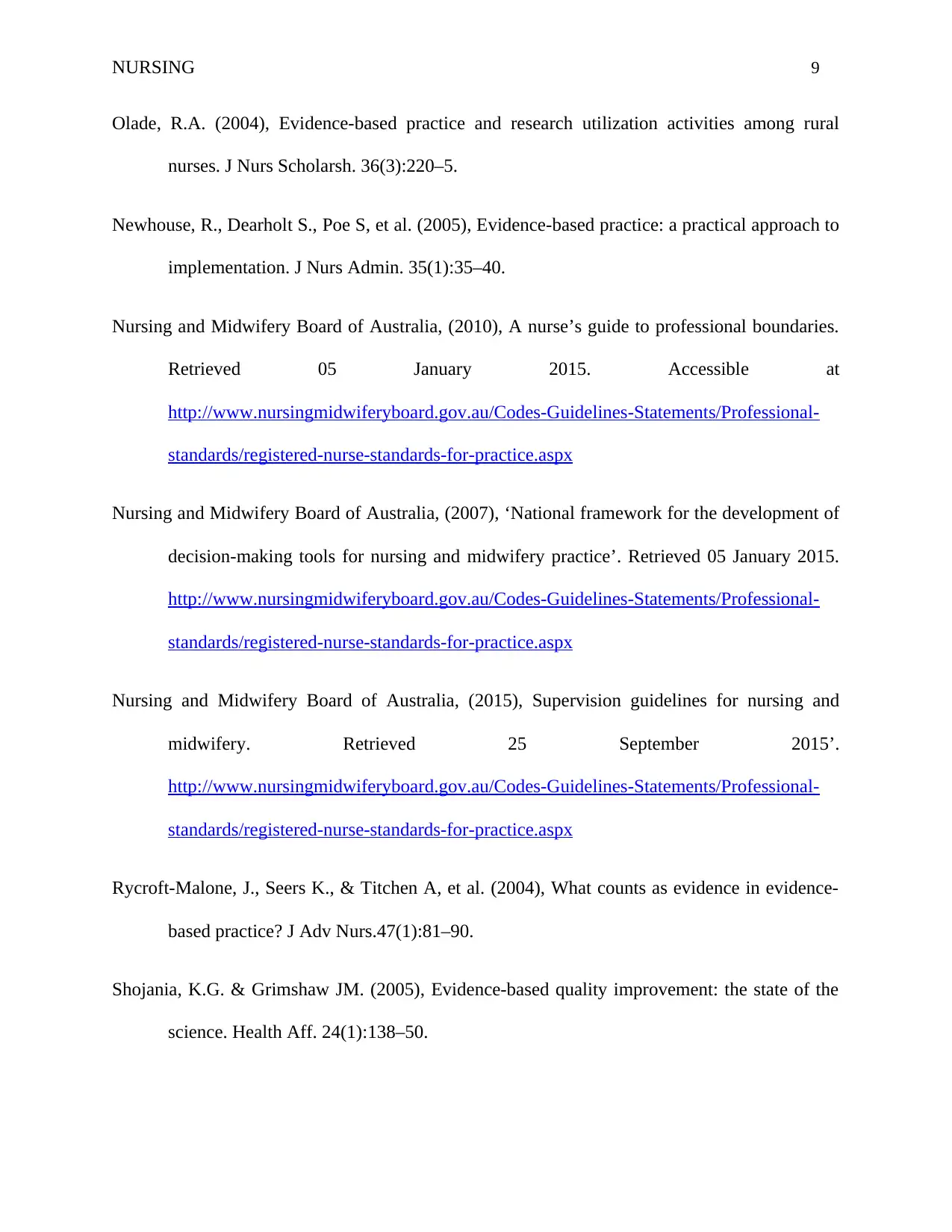
NURSING 9
Olade, R.A. (2004), Evidence-based practice and research utilization activities among rural
nurses. J Nurs Scholarsh. 36(3):220–5.
Newhouse, R., Dearholt S., Poe S, et al. (2005), Evidence-based practice: a practical approach to
implementation. J Nurs Admin. 35(1):35–40.
Nursing and Midwifery Board of Australia, (2010), A nurse’s guide to professional boundaries.
Retrieved 05 January 2015. Accessible at
http://www.nursingmidwiferyboard.gov.au/Codes-Guidelines-Statements/Professional-
standards/registered-nurse-standards-for-practice.aspx
Nursing and Midwifery Board of Australia, (2007), ‘National framework for the development of
decision-making tools for nursing and midwifery practice’. Retrieved 05 January 2015.
http://www.nursingmidwiferyboard.gov.au/Codes-Guidelines-Statements/Professional-
standards/registered-nurse-standards-for-practice.aspx
Nursing and Midwifery Board of Australia, (2015), Supervision guidelines for nursing and
midwifery. Retrieved 25 September 2015’.
http://www.nursingmidwiferyboard.gov.au/Codes-Guidelines-Statements/Professional-
standards/registered-nurse-standards-for-practice.aspx
Rycroft-Malone, J., Seers K., & Titchen A, et al. (2004), What counts as evidence in evidence-
based practice? J Adv Nurs.47(1):81–90.
Shojania, K.G. & Grimshaw JM. (2005), Evidence-based quality improvement: the state of the
science. Health Aff. 24(1):138–50.
Olade, R.A. (2004), Evidence-based practice and research utilization activities among rural
nurses. J Nurs Scholarsh. 36(3):220–5.
Newhouse, R., Dearholt S., Poe S, et al. (2005), Evidence-based practice: a practical approach to
implementation. J Nurs Admin. 35(1):35–40.
Nursing and Midwifery Board of Australia, (2010), A nurse’s guide to professional boundaries.
Retrieved 05 January 2015. Accessible at
http://www.nursingmidwiferyboard.gov.au/Codes-Guidelines-Statements/Professional-
standards/registered-nurse-standards-for-practice.aspx
Nursing and Midwifery Board of Australia, (2007), ‘National framework for the development of
decision-making tools for nursing and midwifery practice’. Retrieved 05 January 2015.
http://www.nursingmidwiferyboard.gov.au/Codes-Guidelines-Statements/Professional-
standards/registered-nurse-standards-for-practice.aspx
Nursing and Midwifery Board of Australia, (2015), Supervision guidelines for nursing and
midwifery. Retrieved 25 September 2015’.
http://www.nursingmidwiferyboard.gov.au/Codes-Guidelines-Statements/Professional-
standards/registered-nurse-standards-for-practice.aspx
Rycroft-Malone, J., Seers K., & Titchen A, et al. (2004), What counts as evidence in evidence-
based practice? J Adv Nurs.47(1):81–90.
Shojania, K.G. & Grimshaw JM. (2005), Evidence-based quality improvement: the state of the
science. Health Aff. 24(1):138–50.
⊘ This is a preview!⊘
Do you want full access?
Subscribe today to unlock all pages.

Trusted by 1+ million students worldwide
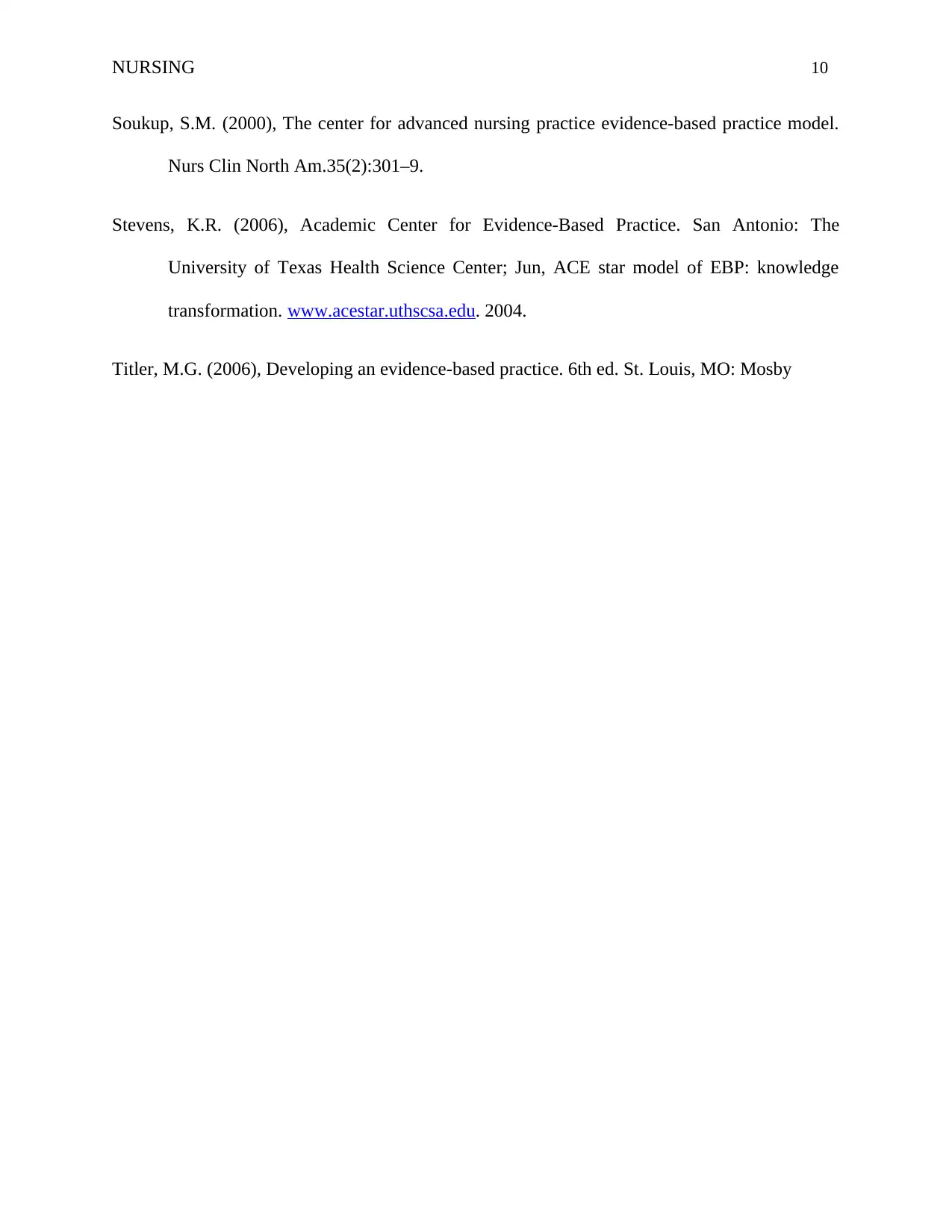
NURSING 10
Soukup, S.M. (2000), The center for advanced nursing practice evidence-based practice model.
Nurs Clin North Am.35(2):301–9.
Stevens, K.R. (2006), Academic Center for Evidence-Based Practice. San Antonio: The
University of Texas Health Science Center; Jun, ACE star model of EBP: knowledge
transformation. www.acestar.uthscsa.edu. 2004.
Titler, M.G. (2006), Developing an evidence-based practice. 6th ed. St. Louis, MO: Mosby
Soukup, S.M. (2000), The center for advanced nursing practice evidence-based practice model.
Nurs Clin North Am.35(2):301–9.
Stevens, K.R. (2006), Academic Center for Evidence-Based Practice. San Antonio: The
University of Texas Health Science Center; Jun, ACE star model of EBP: knowledge
transformation. www.acestar.uthscsa.edu. 2004.
Titler, M.G. (2006), Developing an evidence-based practice. 6th ed. St. Louis, MO: Mosby
1 out of 10
Related Documents
Your All-in-One AI-Powered Toolkit for Academic Success.
+13062052269
info@desklib.com
Available 24*7 on WhatsApp / Email
![[object Object]](/_next/static/media/star-bottom.7253800d.svg)
Unlock your academic potential
Copyright © 2020–2025 A2Z Services. All Rights Reserved. Developed and managed by ZUCOL.





